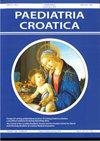The Effect of Play Activities for COVID-19 Positive and MIS-C Pediatric Patients on the Anxiety and Fear of Children and Their Parents
Q4 Medicine
引用次数: 0
Abstract
Aim: This study aims to determine the effects of play activities for COVID-19 positive and MIS-C pediatric patients on the anxiety and fear of children and their parents. Methods: This is an experimental study that was prepared through STROBE. The study population consisted of 38 children treated in a university hospital COVID-19 unit. The Children’s Anxiety Meter-State and the Children’s Fear Scale were administered before and after the play activities. The parents’ fear and anxiety were assessed using the COVID-19 Phobia Scale and the Beck Anxiety Inven- tory. The book and coloring set was prepared in advance and delivered to the experimental group in a package. After the sets were given to the parents, the parents read the book to their children the same day. Afterward, they were asked to color pictures of coro- navirus precautions together with the children. SPSS 22.00 package program was used to analyze the study data. The Mann-Whit- ney U test was used to compare independent groups, and Wilcoxon analysis was used to analyze dependent variables before and after the play activities. Results: Based on the children’s anxiety and fear scores in the experimental group, significant differences were found before and after the play activities and significant differences between the anxiety scores (<0.05) of parents and children. However, no significant difference was found between post-play anxiety and fear scores of children in the experimental group and the scores of the control group. Discussion: The experimental group had low mean anxiety and fear scores after the play activities. Play activities should be used to reduce the anxiety and fear of children who are treated in isolation in hospitals during the COVID-19 pandemic. Even if children are restricted to isolation rooms, their daily routines should be maintained, and their parents should be supported.新冠肺炎阳性和MIS-C儿童患者游戏活动对儿童及其父母焦虑和恐惧的影响
目的:本研究旨在了解COVID-19阳性和misc患儿游戏活动对儿童及其家长焦虑和恐惧的影响。方法:采用频闪法制备实验研究。研究人群包括38名在大学医院COVID-19病房接受治疗的儿童。在游戏活动前后分别测量儿童焦虑量表和儿童恐惧量表。采用新冠病毒恐惧症量表和贝克焦虑量表对家长的恐惧和焦虑进行评估。书本和涂色套装提前准备好,打包送到实验组。在把书交给父母后,父母当天就给孩子们读了这本书。之后,他们被要求和孩子们一起给冠状病毒预防措施的图片上色。采用SPSS 22.00软件包对研究数据进行分析。独立组间比较采用mann - white - ney U检验,游戏活动前后因变量分析采用Wilcoxon分析。结果:从实验组儿童的焦虑、恐惧得分来看,游戏活动前后存在显著差异,家长与儿童的焦虑得分差异显著(<0.05)。然而,实验组儿童的游戏后焦虑和恐惧得分与对照组儿童的游戏后焦虑和恐惧得分没有显著差异。讨论:实验组在游戏活动后的焦虑和恐惧平均得分较低。应利用游戏活动来减少COVID-19大流行期间在医院接受隔离治疗的儿童的焦虑和恐惧。即使儿童被限制在隔离室,也应维持他们的日常生活,并支持他们的父母。
本文章由计算机程序翻译,如有差异,请以英文原文为准。
求助全文
约1分钟内获得全文
求助全文
来源期刊

Paediatria Croatica
医学-小儿科
CiteScore
0.20
自引率
0.00%
发文量
0
审稿时长
6-12 weeks
期刊介绍:
In the inaugural 1956 issue of the journal, the editor Dr Feđa Fischer Sartorius outlined the journal''s vision and objectives saying that the journal will publish original papers on the development, pathology, and health care of children from the prenatal period to their final biological, emotional and social maturity. The journal continues this vision by publishing original research articles, clinical and laboratory observations, case reports and reviews of medical progress in pediatrics and child health.
 求助内容:
求助内容: 应助结果提醒方式:
应助结果提醒方式:


